
The Cycladic culture
In the third millennium BC a remarkable culture developed on the Cyclades, the so-called Cycladic culture, which had an important centre on Naxos. It was one of the first cultures in Europe to take the step into the Bronze age: the Cycladic culture is defined as Early Bronze age, followed by the Minoan epoch (Middle Bronze age) and finally the Mycenaean epoch (Late Bronze age).
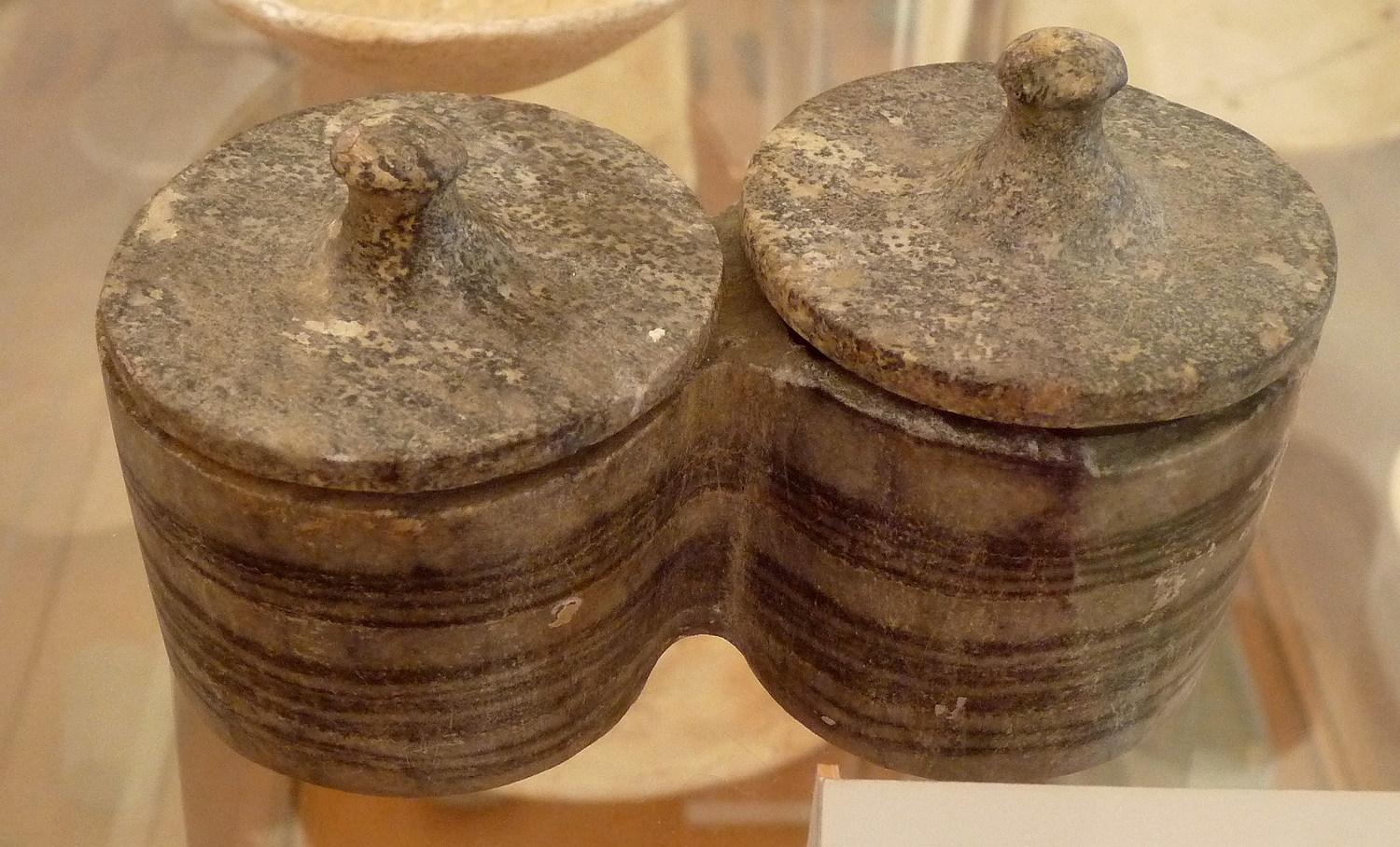
Typical for the Cycladic culture (3rd millennium BC) are elaborate and unique stone vessels such as this twin vessel with lids.
The Cycladic culture can be divided into three phases: an early phase from 3,200 to 2,700 BC (Grotta-Pelos culture), a middle phase from 2,700 to 2,300 BC (Keros-Syros culture) and a late one from 2,300 to 2,000 BC (Kastri or Phylakopi I culture); the phases can be distinguished by the style of the pottery and the stone sculptures.
Most of the known sites of the Cycladic culture on Naxos are cemeteries, while remains of settlements are rare. In most of the cemeteries the graves have been looted and the artifacts have been sold illegally; accordingly, numerous objects of the Cycladic culture are known, but most of them lack an exact location and context. Because of this situation our knowledge of the Cycladic culture is unfortunately quite incomplete.
The people of the Cycladic culture have left us some remarkable, touching artwork. The pottery as well as the stone vessels and idols show a clear and harmonious design, and the great variety of shapes testifies to the inventiveness and imagination of the manufacturers.
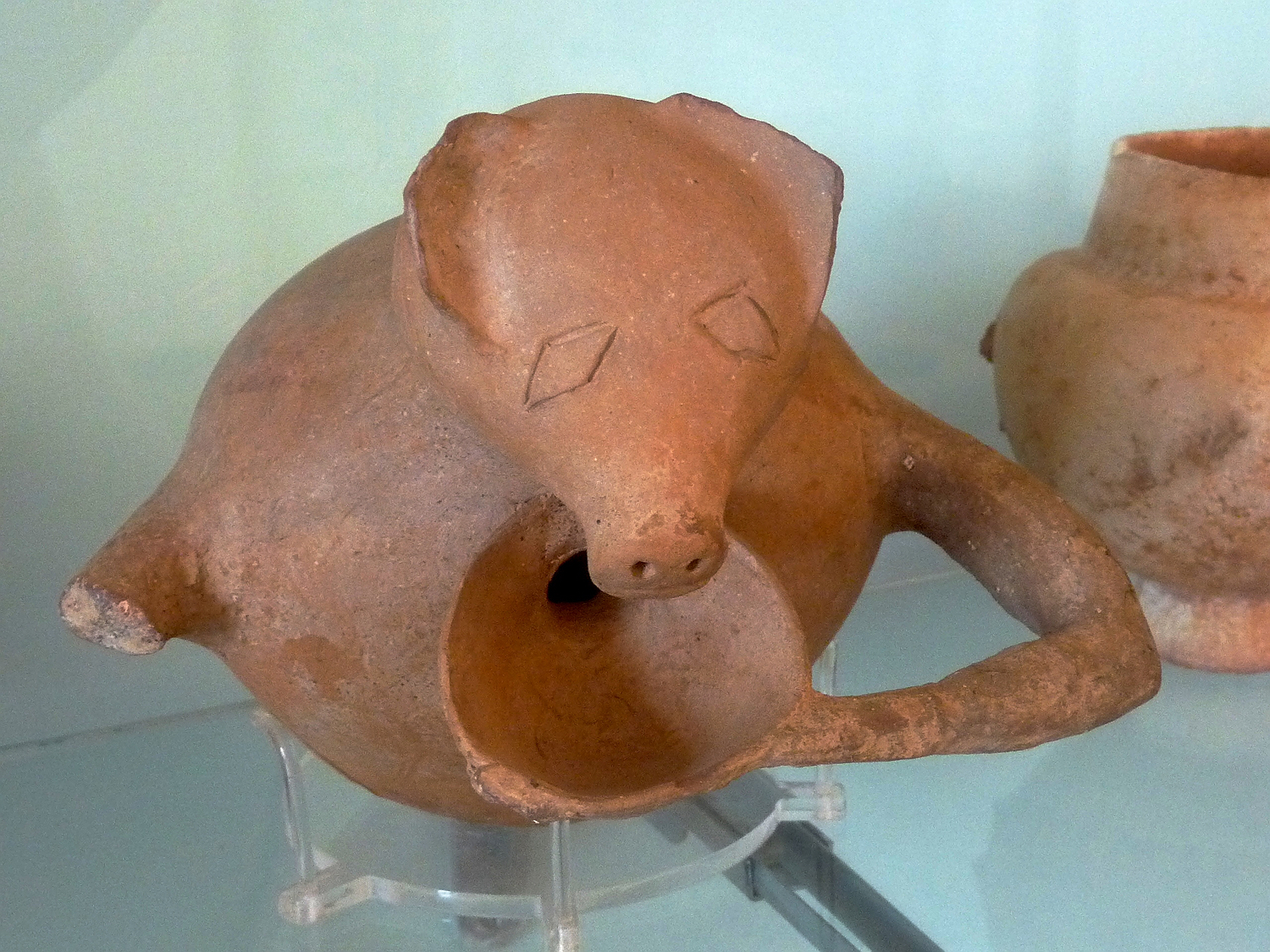
The origin of the Cycladic culture
The Cycladic culture belongs to the Early Bronze age. It developed out of the local Neolithic culture, in which most of its characteristic features start to appear already (e.g. the production of stone idols). The transition was continuous: It was a gradual evolvement, probably stimulated by contacts with neighbouring (eastern) peoples who had already reached a Bronze age stage. There is no evidence to suggest that the step into the Bronze age was accompanied by the immigration of a different population.
It is a question of definition where to set the transition from the Stone age to the Bronze age. For example the important cultural steps of the beginning of agriculture and metal processing took already place in the Neolithic age; on the other hand, the obsidian tools so characteristic of the Stone age were still widely used during the Bronze age. Generally, the beginning of the Bronze age is set when a production of bronze appears, i.e. an artificial alloy in contrast to solid copper, which was used also in the later phase of the Neolithic (the last phase of the Neolithic is accordingly called Copper age). However, on the Cyclades it is hardly possible to make a clear distinction, because the first still rare bronze objects here occur already in the Neolithic age. The knowledge of bronze production spread gradually from the Middle East along with the trade. In Palestine and Mesopotamia, the Bronze age began around 3,300 BC, in Egypt around 2,700 BC and in Central Europe around 2,200 BC. In the Aegean the beginning of the Bronze age is set at 3,200 BC, that is much earlier than in the rest of Europe. According to more recent findings, the production of bronze was possibly discovered in the eastern Balkan region (Romania, Bulgaria, Black Sea region) even earlier than in the Middle East, namely already in the 4th millennium BC. This area was then settled by Thracians, who were probably related to the early Cycladic inhabitants; contacts between the Cyclades and this region have already been for the Neolithic.
more about the peoples and the language of the Cycladic culture
Settlements
During the Neolithic, human settlement on Naxos was probably still sparse. In the Early Bronze age, on the other hand, large areas of the island were inhabited: numerous sites have been found, especially along the south coast of the island from Moutsoúna via Pánormos and the southwest (e.g. Agiassós, Kastráki, Mikrí Vígla and Ágia Ánna) up to the Chóra; other sites have been discovered in the north and in the interior of the island (e.g. near Mélanes, Sangrí, Engarés, Liónas, Apóllonas). The Small Cyclades adjoining to the south and the east, such as Koufonísi and Kéros, were also densely populated with an important and unique centre on the now uninhabited island of Kéros.
In the first phase of the Early Bronze age, the people of the Cyclades lived in individual houses or in tiny settlements. The small houses were built of uncarved stones with earth as mortar; the roof probably consisted of wood and earth. During the second phase of the Cycladic culture, the settlements increased in number and size and the population grew. Scattered settlements in Cycladic style can also be found in the neighbouring regions, in Asia Minor, Crete and on the Greek mainland; these were probably trading settlements of the Cycladic people. During the last phase of the Cycladic culture, many sites were abandoned. Most of the settlements were now fortified; some were situated in places that were not directly visible from the sea, probably because of an increasing threat through pirates.
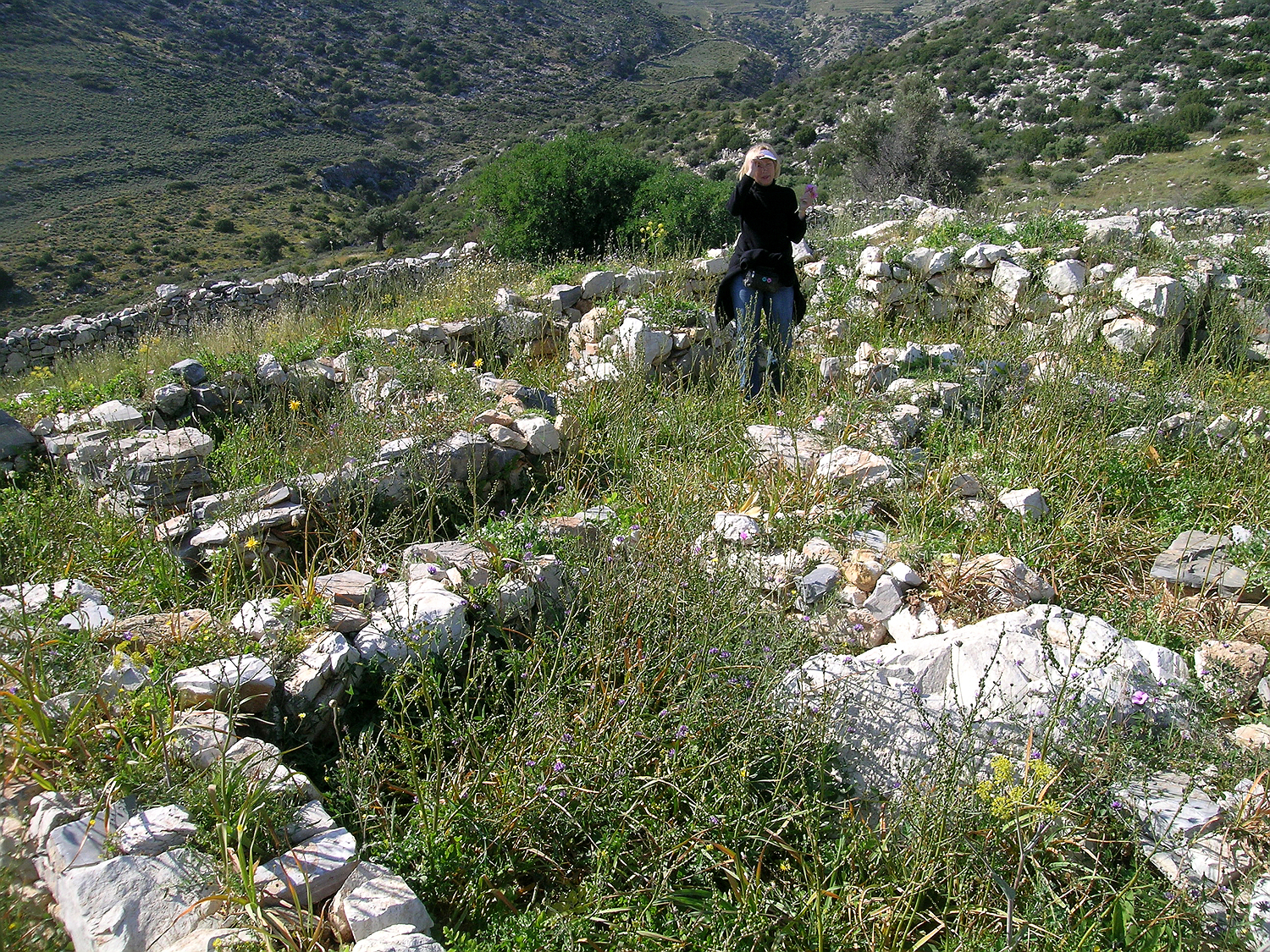
The small fortified acropolis at Korphári ton Amygdalión near Pánormos is probably the oldest preserved building on Naxos.
Agriculture and food
In the early Bronze age, the inhabitants of the Cyclades lived more or less in the same way as in the Neolithic age. They practised a modest agriculture, growing barley, wheat, lentils, peas and other crops. Apart from a bronze sickle, no agricultural tools have been found; probably only wooden tools were used. They collected nuts and almonds and doubtless also wild vegetables and fruit. Cereals and other supplies were kept in large clay vessels. Stone mortars were used to make flour. As in the Stone age, the settlers kept goats and sheep, more rarely pigs and cattle, and hunted deer. Seafood such as fish, snails, mussels and sea urchins were also very popular. The first indications of the use of the olive tree and the vine in the Cyclades (oil lamps and vessels that are thought to be wine jugs) date from the Early Bronze age.
The crafts
During the Early Bronze age, as in the Neolithic, obsidian was widely used for the production of numerous tools. In particular long narrow blades with parallel edges are characteristic of this period. Crafts such as pottery, the manufacture of stone vessels and metalworking also developed greatly during the Early Bronze age.
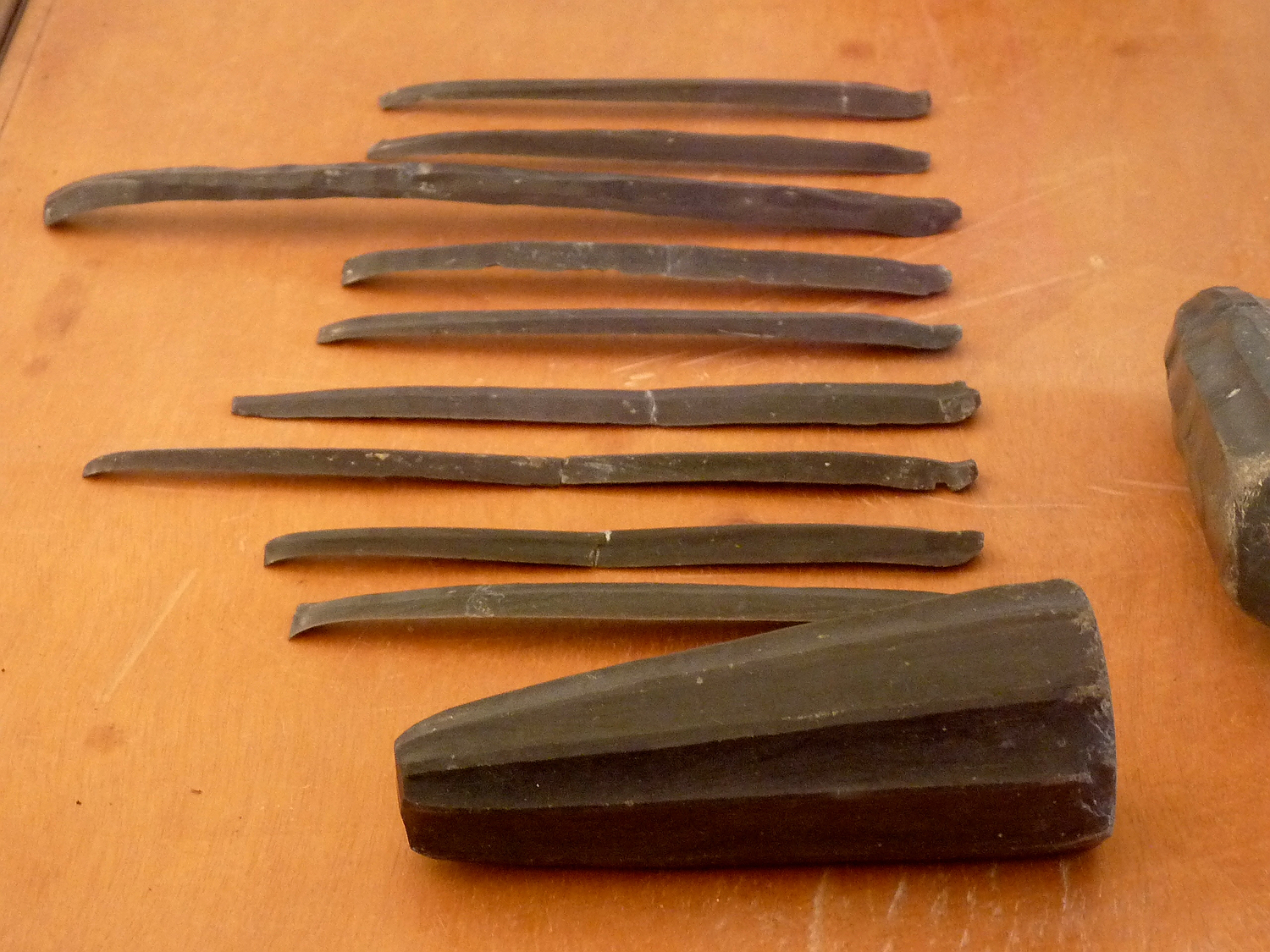
long obsidian blades and a core, from which the blades were split off, in the Archaeological Museum in the Chóra
Our knowledge about the crafts in the Early Bronze age is fragmentary. We know that wool and flax were used, but of the weaving and spinning as well as leather processing only the tools, such as needles, awls and weaving weights, have survived. We don’t know much about the carpentry either: It seems that the Cycladic people hardly made any furniture yet. However, they already built seaworthy ships with which they not only explored the whole Mediterranean, but probably even ventured into the Atlantic. Numerous carpentry tools such as axes, chisels and saws are known from the later phases of the Cycladic culture.
The production of pottery developed significantly during the Early Bronze age. Countless clay vessels and shards found in graves or settlements give us an idea of the daily way of life and the sense of art of the people. Over time the quality of the pottery improved and its design and decoration became more elaborate, and new, often imaginative and refined forms emerged. In the last phase of the Early Bronze age, a whole series of new types of vessels came to the Cyclades, especially from the Trojan region, with which particularly close ties existed.
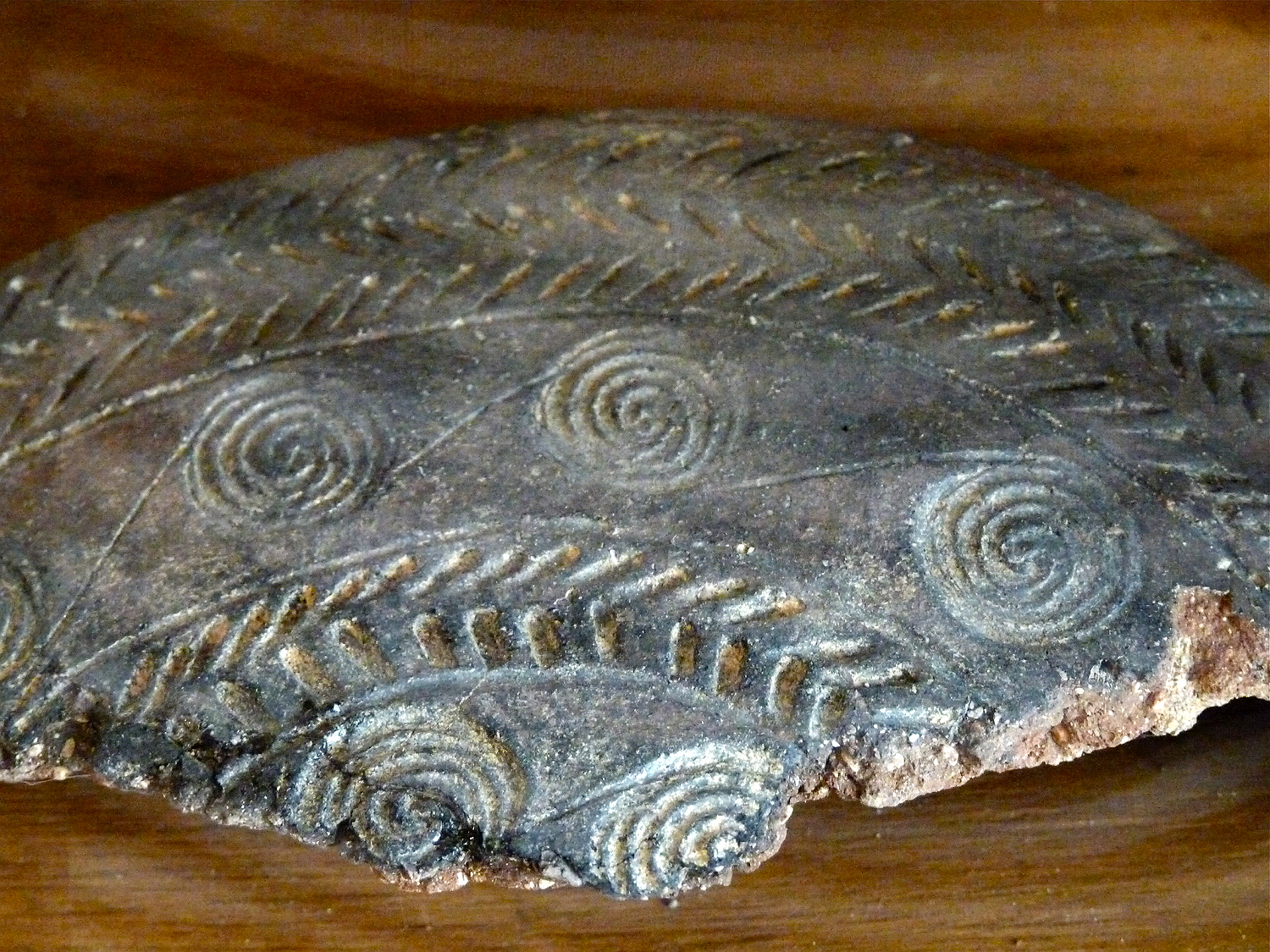
fragment of a “Cycladic pan” in the Museum of Apíranthos
Most characteristic of the Cycladic culture are its stone vessels, which were usually made of marble, more rarely of other kinds of stone. The stone vessels are often very similar to pottery in shape and decoration. The Cycladic people not only made bowls out of stone, but also cylindrical vessels with lids (pyxides), thin-walled cups, goblets and vases. Emery was used to hollow out the stone vessels as well as to drill the holes for the handles, probably mostly as a coarse powder, which was used for grinding with the help of a piece of wood. Many stone vessels are elaborately decorated with carvings similar to those of pottery.
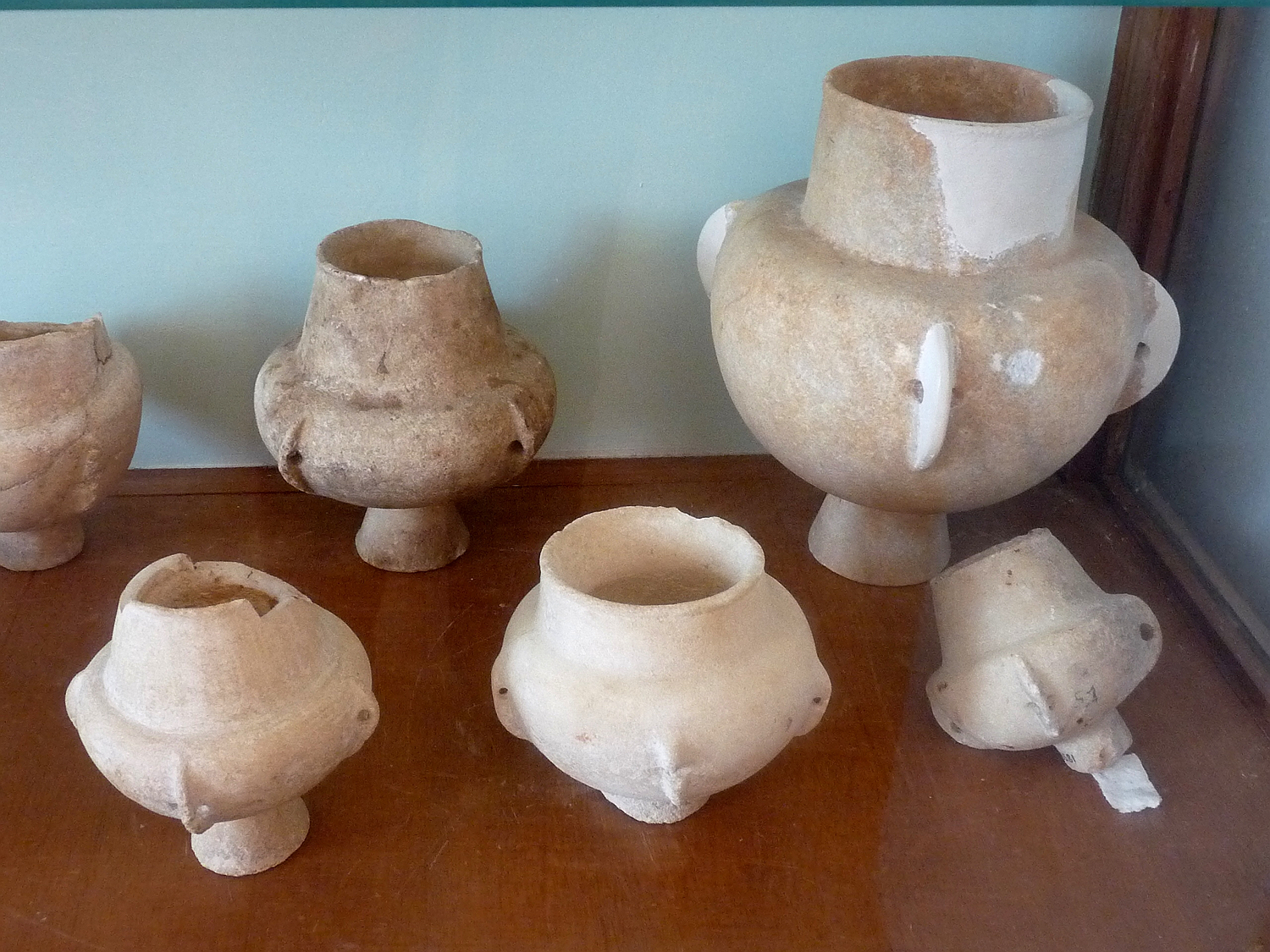
stone vases in the museum in the Chóra
more about crafts and techniques
The metal crafts
The Cycladic culture was one of the first European cultures to use and process metal to a greater extent. Although individual metal objects appeared in the Aegean Sea already during the Neolithic age (copper pieces and crucibles in the Neolithic settlement of Kephala, but also bronze tools, e.g. in the Cave of Mount Zeus), metal only started to play a greater role in daily life from the Bronze age onwards.
In the first phase of the Cycladic culture metal objects are still rare and consist mainly of copper, silver and lead. Silver was used for the manufacture of jewellery, and lead was used to repair broken clay or marble objects: The pieces were combined with lead wire or rivets. In the middle phase of the Early Bronze age, metal goods became more abundant, and bronze (an alloy of copper with tin or arsenic) became the most common material, especially for the production of tools.
The first metal utensils are simple tools such as awls and needles, axes, chisels and wedges. Weapons only appear in the late phase of the Cycladic culture. Apart from knives (which of course could also have been used for domestic purposes), those consist mainly of spearheads; swords are only known from the end of the Cycladic culture. Noteworthy is the lack of farming equipment, but here of course we must always consider when evaluating the finds that we only know the metal objects that have been conserved. It is possible that the reason why no agricultural tools were found is that their metal was always melted down and reused, while smaller objects such as awls were sometimes lost or given as grave goods.
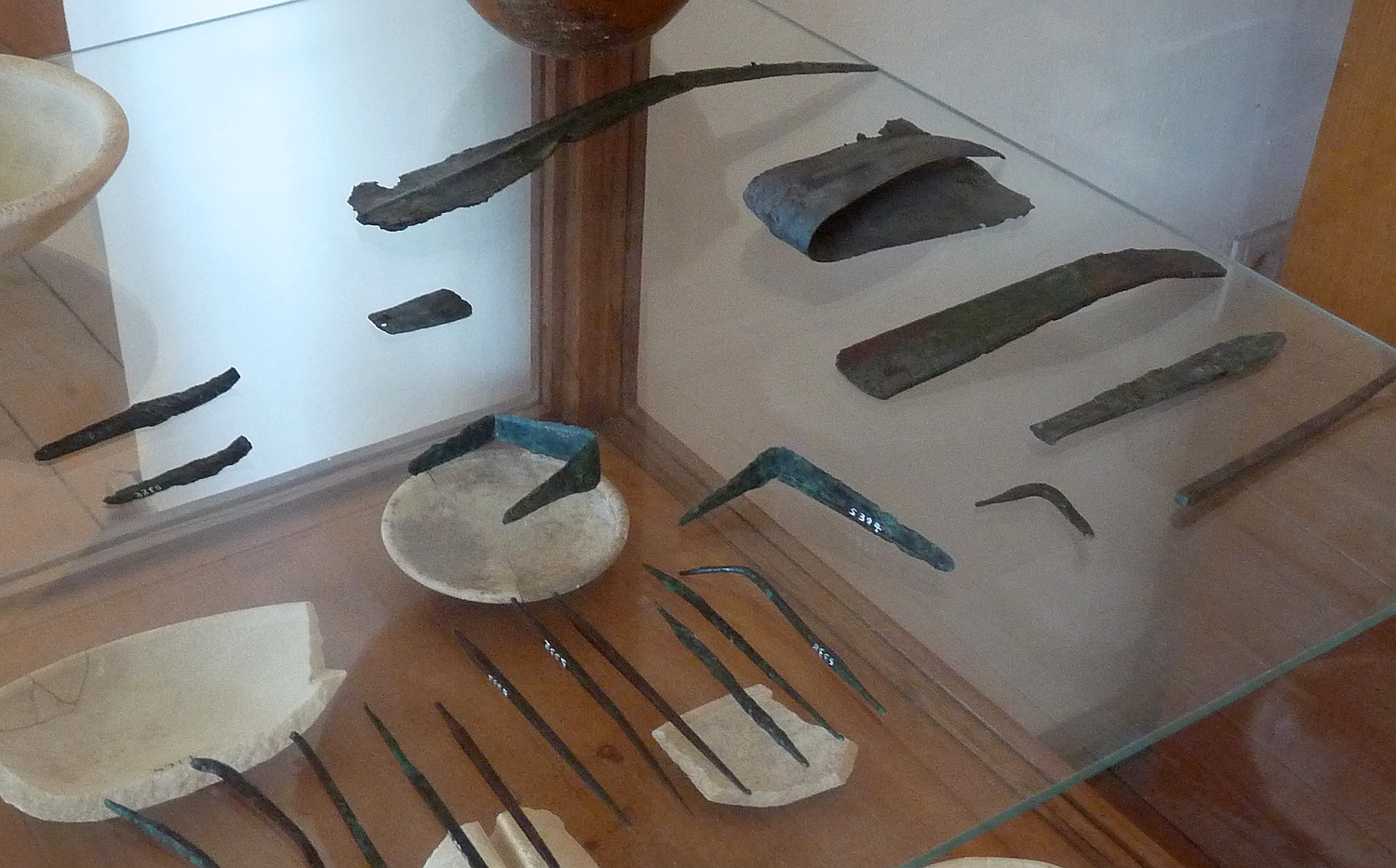
metal tools of the Cycladic culture in the museum in the Chóra
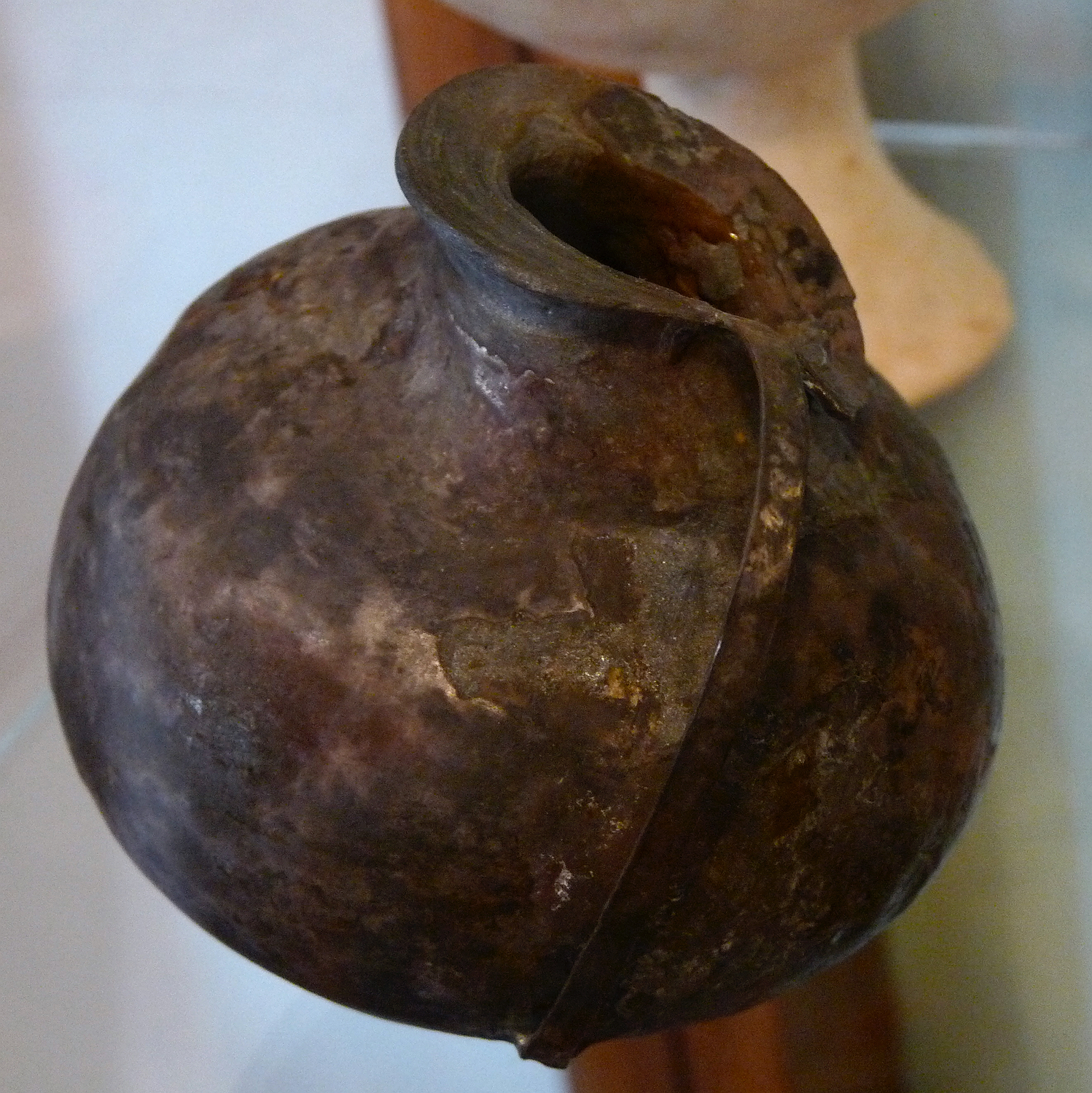
small metal vessel in the museum of Apíranthos
The development of metal tools also gave an important impetus to many other crafts. Of particular importance was the invention of the saw, which only became possible with the development of good bronze alloys, as it was not possible to produce sufficiently strong metal blades from pure copper. It was only after the invention of the saw that ships could be manufactured which consisted of thin wooden planks and were accordingly lighter and suitable for long-distance journeys and trade.
Contacts with neighbouring cultures
The peoples of the Aegean have been trading with their neighbours since the Stone age, especially with raw materials such as the obsidian of Milos or the naxian emery. Metal processing further promoted trade, as the limited local metal resources were soon exhausted. The inhabitants of the Cyclades received many important impulses from these contacts: For example, knowledge of the cultivation of grain, wine and olive trees and of metalworking techniques came from the Levant region; also some idols of the Levant resemble those of the Cyclades. Obvious similarities also exist with the North Aegean and the adjoining Balkan region. For example, many of the vessel forms that became common in the Cyclades in the last phase of the Early Bronze age originated from the region of Troy.
On the other hand the Cycladic people passed on their knowledge to the local cultures of the Greek mainland, Crete and even areas in the western Mediterranean through trade or small trading settlements which they founded there, and thus made an important contribution to their further development.

representation of a ship in a stone pictograph
more about the contacts with the neighboring peoples
more about the seafaring and trade
Cemeteries and burials
Most of our information about the Early Bronze age in the Cyclades is derived from the study of cemeteries, especially grave goods. There are considerably more cemeteries known than settlements. The dead were buried in stone box graves lying on their sides; in the later phases the graves were often used for several burials. Often grave goods were placed in the graves, which presumably were considered to be useful to the dead in their afterlife. The most common grave goods were round pebbles, obsidian blades and clay or stone vessels; more rare were pieces of jewellery or weapons. The rarest, but also most interesting and characteristic grave goods were the famous Cycladic idols.
more about cemeteries and burials
The Cycladic idols
The most famous artefacts of the Cycladic culture are the marble idols. These unique works of art give testimony in a particularly impressive way to the craftsmanship and artistry of this small people. Cycladic idols were found almost exclusively in graves. Despite many speculations their exact function is unclear. Possibly they were images of a female deity who was worshipped as the ruler of life and death, as it was common in the Orient. The Cycladic idols have a characteristic flat shape and a strange posture with a slightly reclined head, slightly bent legs and feet; the arms are held over the belly. The shape and proportions of the idols were carefully determined according to fixed principles. The idols are of a simplicity, elegance and expressiveness that still impresses us today.

Cycladic idols in the Archaeological Museum in the Chóra
The end of the Cycladic culture
At the end of the 3rd millennium BC the Cycladic culture came to an end and was replaced by the Minoan period of the Middle Bronze age (about 2,000 to 1,500 BC). This phase was accompanied by warlike conflicts and migrations of parts of the population. Population density and production declined, but technically and artistically sophisticated objects were still produced. The Cyclades were now displaced from their pioneering role in the Aegean and the larger Crete took over the supremacy.
see also:
- The history of Naxos
- The Paleolithic and Mesolithic age
- The Neolithic age
- The Minoan epoch
- The Early Bronze age acropolis in Panormos
- The Early Bronze age sanctuary Koryfi t’Aroniou
information based on:
- Kunst der Kykladen im Jahr 3000 v. Chr.; Red.: Jürgen Timme, Badisches Landesmuseum Karlsruhe, Müller Verlag, Karlsruhe 1976
- Cycladic culture, Naxos in the 3rd Millenium BC; Editor: Lila Marangou, Nicholas P. Goulandris Foundation, Museum of Cycladic Art, Athen 1990
- The Emergence of Civilisation, The Cyclades and the Aegean in the third Millenium BC; Colin Renfrew; Oxford Books, Oxford 2011
- Naxos Denkmäler und Museum; Photini Zaphiropoulou; Krene Verlag, Athen 1988
- Kunst und Kultur der Kykladen, Teil I: Neolithikum und Bronzezeit und Teil II: Geometrische und Archaische Zeit; Werner Ekschmitt; Verlag Philipp von Zabern, Mainz am Rhein 1986